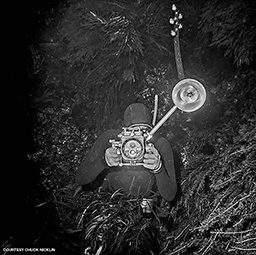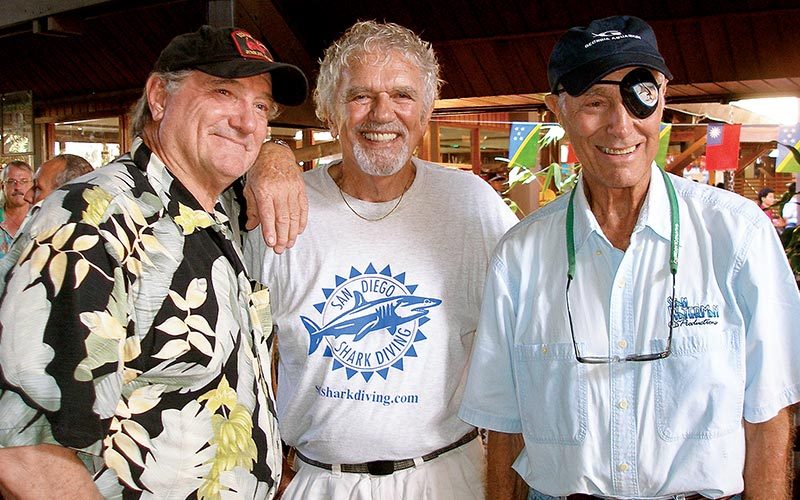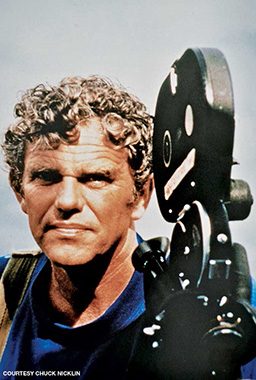Hometown: San Diego, Calif.
Years Diving: Scuba diving, 61; freediving, 66
Favorite Dive Destination: Papua New Guinea. It offers the most varied dive opportunities I’ve experienced, including muck, sharks, reefs, wrecks — everything.
Why I’m a DAN Member: Someday something might happen to me in some crazy place, and I might need it!
Think you don’t know underwater cameraman Chuck Nicklin? Think again. If you’ve seen a James Bond film, then you may have seen an underwater sequence Nicklin filmed. If you own an underwater camera, chances are good you have read an article by or taken a class from a photographer who worked with him. His dive business (the legendary Diving Locker in San Diego, Calif.), photography and videography are embedded in the heart of diving history, and that influence continues today.

Alert Diver:So let’s talk numbers and facts first. I have to know — how many dives have you logged? And where did you do your coldest and warmest dives?
Chuck Nicklin: I always write 5,733 as my number of dives, but I honestly have no idea. My coldest dive was under 9 feet of ice in Antarctica; I think the temperature was about 27°F. My warmest dive was in Papua New Guinea in 87°F water.
AD: What was your most memorable in-water experience?
CN: My most memorable experience was the first time I dived with humpback whales in Hawaii. I’ll never forget the first time I saw a humpback coming toward me.
AD: You were one of the founders of the Diving Locker. From the stories I’ve heard and photos I’ve seen, it seems inadequate to call it a dive shop — it inspired a diving lifestyle in California and beyond.
CN: The Diving Locker opened in June 1959. Back then there just wasn’t a lot going on with diving in the U.S. Most people weren’t following Jacques Cousteau quite yet, but for those of us who were, diving really opened up possibilities. There was a great white shark attack at La Jolla Cove the day before we opened — the timing couldn’t have been more awful. I think on the day we opened we sold three or four Skin Diver magazines and nothing else. Not long after that, Cousteau actually came into the shop to introduce our first class to his film, The Silent World.

AD: The Diving Locker produced a number of well-known underwater photographers. Is that part of what stands out for you about that time?
CN: In some ways, yes, Ron Church, a good friend and a great photographer, worked with me. He had a Rolleimarin [a housing for the medium-format Rolleiflex camera], and he’d share it with me. Between us we had 12 exposures per dive, so each of us would shoot six photos. Marty Snyderman was another big-name shooter who worked at the Diving Locker, as was Howard Hall and my son, Flip. Over the years, a lot of kids came to work for me. It was their first time seeing how a business was run, and I really enjoyed that part of the job. I liked helping those kids progress into the real world. It’s great to hear from people who used to work for me back then who are now successful in their professional lives, either within or outside of diving and photography.

AD: I can name more than a few photographers who see you as a mentor. I remember seeing you the first time I attended a local underwater photography club meeting in San Diego. I was pretty surprised to see Chuck Nicklin, one of the pioneers of underwater photography, sitting in the front of the room.
CN: I still attend local underwater photography and underwater film club meetings. Anyone can buy a camera, go on a boat, or go for a dive. But not everyone can see “the picture.” I try to go out of my way to encourage serious photographers.
AD: A few months ago I saw a photo of you, Al Giddings and Stan Waterman that was circulating on social media. You are three of what could be considered the first generation of underwater photographers. What was that like, and what has changed?
CN: That was funny. Al and I were in the Solomon Islands, and we happened to run into Stan in the Honiara airport, of all places. Of course, one important person is missing from that photo: Jack McKenney. I remember when we were all four working in diving in the U.S. or Bahamas as spearfishermen, and we realized that there was opportunity in photography and started shooting photos instead. I think of that time as the “era of film.” Now with everything digital, you can make a name for yourself with a little luck and exposure on social media, but back then, that wasn’t the case. There was a lot less competition in underwater photography, but to get your foot in the door you really needed to know someone.
AD: You worked forNational Geographicin the early years — that’s quite a big door to get your foot into. How did you do it?
CN: One day I was diving with friends off La Jolla, Calif., and we came across a Bryde’s whale tangled in a gill net. I climbed on the whale’s back to cut him loose, and my buddy Bill DeCourt took a photo of me. That photo was published everywhere, so when National Geographic wanted to run an article on whales, they sent out photographer Bates Littlehales to learn how to shoot whales from us. Bates started hiring me as his assistant for other shoots, and the rest is history.

AD: I read an article about you years ago that described your ability to sleep anywhere. I imagine that has come in handy a time or two.
CN: I remember filming The Deep in Bermuda. We had these plywood huts, one for each of the principal actors, and one for the camera people. Al [Giddings] kept ours very neat, which worked out really well for me. There was a camera bench with a shelf under it. There would be towels draped over the top, and I’d just curl up on that hidden shelf and sleep whenever we got a break from filming. The other guys would often get frustrated and sunburned, but not me!
D: You’ve done some feature film work:The Deep, The Abyss,a few James Bond flicks. What do you remember the most?
CN: Spitting in Sean Connery’s mask to clear it for his close-up during the filming of Never Say Never Again.
AD: Is that all you’re going to tell us? I’ve heard you are working on a book. Will that include more about your film experiences?
CN: My wife, Roz, and I are really excited about my book — she helped edit most of it. It’s about my career in underwater photography, including some behind-the-scenes stories from feature films, plus accounts about diving, travel and conservation. By telling these stories I hope to be able to inspire people to dive and travel, to see new places and have new experiences and to hopefully gain a new outlook on life.
Explore More
Watch Outside Television’s interview with Chuck Nicklin.
Nicklin was honored with the DEMA Reaching Out Award in 2010. Learn more about his accomplishments in their video about him.
© Alert Diver — Q3 Summer 2015